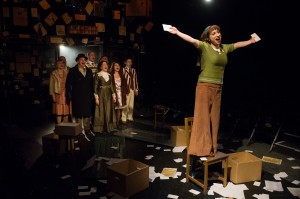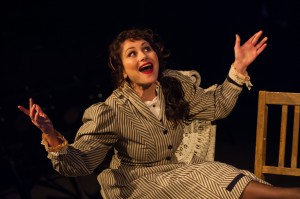There is something very intriguing and distinctly admirable about the creation of a piece of theatre from subject matter that is unlikely and unusual. Most people would be completely unaware that somebody actually wrote the iconic London A-Z. They’d be even less aware it was a portrait painter called Phyllis Pearsall who came up with the idea and even less aware again of the interesting twists and turns her life took as she created it. Yet it is Pearsall’s colourful life on which The A-Z of Mrs P, with book by Diane Samuels and music and lyrics by Gwyneth Herbert, is based.
The use of the space in Southwark Playhouse’s “Large” is truly excellent and Klara Zieglerova’s design is innovative and inspiring. All manner of paraphernalia – postcards, books, maps, chairs, papers, suitcases – hangs from the ceiling, reflecting a life of thought, travel and work. The audience is seated either side of an oblong space flanked at each end with moveable doors that are controlled by cast members. The band is visible on a raised platform.
Beginning with her decision to leave her husband in Venice and step out into her beloved London to pursue her painting career, the piece explains the inspiration behind Pearsall’s famous map book, cataloguing its creation, introducing the draughtsmen she recruited along the way to assist her, her commendable decision to convert her company into a trust for the benefit of her employees and her later physical decline. All set against a backdrop of turbulent family life which veers from great affluence to bankruptcy and, owing largely to the selfish, misogynistic antics of her father, features the death of her mother in an asylum.
The action is relatively fast paced throughout and Gwyneth Herbert’s score and lyrics are punchy, quirky and decidedly “Sondheimesque”. Pretty impressive for someone who claims never to have seen a stage musical before starting the project. One particular highlight is a song which sees Pearsall (played by Isy Suttie) relay the names of 70 London streets in quick succession as they are recorded in the book. It is often really a fun form of recitative, but Suttie embraces the challenge of her first musical role head-on, giving a performance which manages to be sympathetic, endearing, independent and vulnerable all at the same time. Other casting highlights include Frances Ruffelle, whose Bella is tragic, sexy and gritty and Stuart Matthew Price, who is in beautiful singing voice as Pearsall’s brother, Tony.
For a piece that is supposed to be largely about the life and achievements of one protagonist, though, this show meanders decidedly off course at times. For example, it allows itself to focus too heavily on Pearsall’s father. Played adeptly by Michael Matus, who is also in fantastic voice, this man not only shapes the lives of his wife and daughter to a staggering degree, but dominates the theatrical proceedings themselves. Whilst this obviously makes sense on some level, he just becomes annoying by the end and, to be honest, I’d rather have seen more time spent exploring further aspects of the life and plight of Phyllis herself.
The highlights of this show are many. Its charm is undeniable, there is much to enjoy and the passion and thought behind it are obvious. However structurally it currently feels a little like an experimental work in progress.
Photos by Jane Hobson



